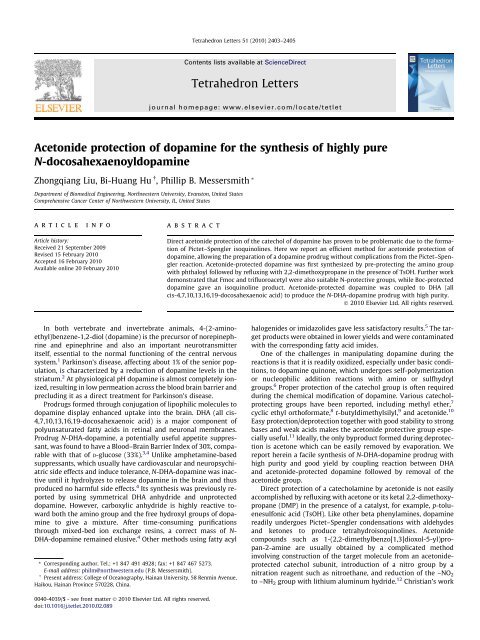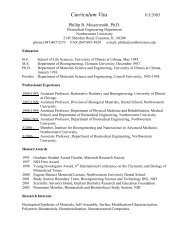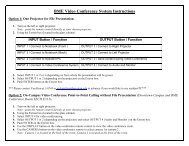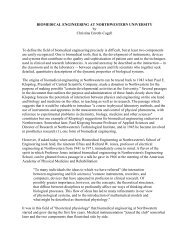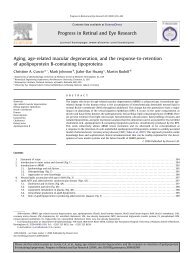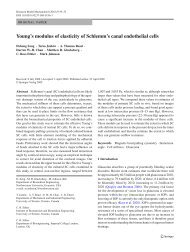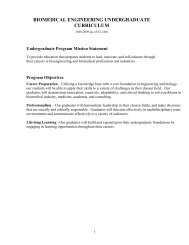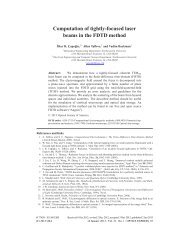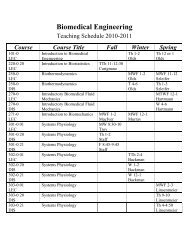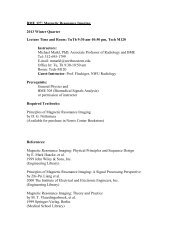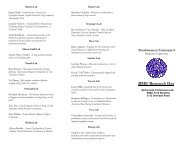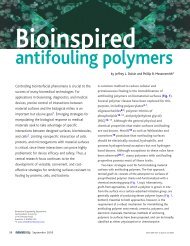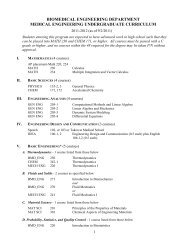Acetonide protection of dopamine for the synthesis of highly pure N ...
Acetonide protection of dopamine for the synthesis of highly pure N ...
Acetonide protection of dopamine for the synthesis of highly pure N ...
Create successful ePaper yourself
Turn your PDF publications into a flip-book with our unique Google optimized e-Paper software.
2404 Z. Liu et al. / Tetrahedron Letters 51 (2010) 2403–2405demonstrated that when <strong>dopamine</strong> was blocked as a glucoamide,direct acetonide cyclization was readily accomplished by refluxingin acetone. 13,14 Considering that <strong>the</strong> cleavage <strong>of</strong> a glucoamide bondto free up <strong>the</strong> <strong>dopamine</strong> may require harsh conditions, <strong>for</strong> example,heating in strongly basic solution, 15 we decided to explore astrategy using an easily introducible and removable N-protectinggroup to temporarily mask <strong>the</strong> amino group <strong>of</strong> <strong>dopamine</strong> followedby refluxing with DMP in <strong>the</strong> presence <strong>of</strong> TsOH. A systematic studywas also carried out to screen <strong>the</strong> amino-protecting groups, includingcyclic imide, carbamate, and amide.One <strong>of</strong> <strong>the</strong> simplest methods to differentiate <strong>the</strong> reactivity <strong>of</strong><strong>the</strong> amino and <strong>the</strong> catechol group is to <strong>for</strong>m an ammonium saltby protonation with strong acids. For example, selective acetylation<strong>of</strong> <strong>the</strong> catechol <strong>of</strong> 3,4-dihydroxyphenylalanine (DOPA) wasachieved by protonation <strong>of</strong> <strong>the</strong> amino group with hydrogen chlorideor bromide. 16,17 Un<strong>for</strong>tunately, refluxing <strong>dopamine</strong> hydrochloridewith acetone gave a Pictet–Spengler isoquinoline instead <strong>of</strong> anacetonide product (Scheme 1). 18Complete removal <strong>of</strong> <strong>the</strong> hydrogen atoms <strong>of</strong> <strong>the</strong> amino groupmay provide sufficient <strong>protection</strong> <strong>for</strong> acetonide cyclization <strong>of</strong> a catecholamine.For this purpose, <strong>the</strong> N-phthaloyl (Phth) protectivegroup was introduced to <strong>dopamine</strong> by N-carbethoxyphthalimidein methanol. The resulting Phth-<strong>dopamine</strong> (1) was <strong>the</strong>n refluxedwith DMP and a catalytic amount <strong>of</strong> TsOH in benzene. To shift<strong>the</strong> reaction equilibrium, volatile byproducts were removed from<strong>the</strong> reaction system by distillation. The condensed liquid was recycledusing a Soxhlet extractor, <strong>the</strong> thimble <strong>of</strong> which was filled withanhydrous CaCl 2 to absorb water and methanol. In addition, anhydroussolvent and argon <strong>protection</strong> were used to prevent <strong>the</strong> introduction<strong>of</strong> water from external sources, shortening <strong>the</strong> reactiontime from 24 h to ca 1–2 h sometimes required <strong>for</strong> traditionalmethods. 21 The raw product was subjected to GC–MS analysis,which gave a major peak in <strong>the</strong> chromatogram and a molecularion at 323 (calcd 323.12) in <strong>the</strong> mass spectrum, indicating that full<strong>protection</strong> <strong>of</strong> <strong>the</strong> amino group results in acetonide cyclizationra<strong>the</strong>r than isoquinoline <strong>for</strong>mation. The identification <strong>of</strong> Phth<strong>dopamine</strong>(acetonide)(2) was fur<strong>the</strong>r confirmed by high resolutionmass spectrometry (HRMS) and nuclear magnetic resonance(NMR) spectroscopy, with <strong>the</strong> latter showing a peak at d ppm117.8 <strong>for</strong> <strong>the</strong> quaternary carbon <strong>of</strong> <strong>the</strong> acetonide group. <strong>Acetonide</strong>-protected<strong>dopamine</strong> (3) 22 was obtained by de<strong>protection</strong> <strong>of</strong><strong>the</strong> phthaloyl group <strong>of</strong> 2 with hydrazine in DCM. In a previousapplication <strong>of</strong> this strategy, Phth-protected DOPA methyl esterwas converted to Phth-DOPA(acetonide)-OMe leading to <strong>the</strong> syn<strong>the</strong>sis<strong>of</strong> Fmoc-DOPA(acetonide)-OH, a useful intermediate toincorporate DOPA into syn<strong>the</strong>tic peptides. 10The use <strong>of</strong> hazardous hydrazine 23 and <strong>the</strong> difficulty to removehydrazide byproduct 24,25 during dephthalylation <strong>of</strong> Phth-DOPA(acetonide)-OMe prompted us to examine o<strong>the</strong>r N-protectinggroups, such as <strong>the</strong> carbamates Boc and Fmoc and <strong>the</strong> amide trifluoroacetyl(Tfa), which remove only one <strong>of</strong> <strong>the</strong> two hydrogen atoms<strong>of</strong> <strong>the</strong> amino group. The introduction <strong>of</strong> a carbonyl group adjacentto <strong>the</strong> nitrogen atom followed by protonation <strong>of</strong> <strong>the</strong> amide nitrogenmay <strong>for</strong>m an N-acyliminium ion, which probably facilitatesPictet–Spengler-type reactions due to <strong>the</strong> increased electrophilicreactivity. 26 However, acetonide cyclization may still be favoredif <strong>the</strong> reaction is carried out in an aprotic solvent with only catalyticamount <strong>of</strong> acids.Fmoc- and Boc-protected <strong>dopamine</strong> behaved quite differentlywhen refluxed with DMP and TsOH. Fmoc-<strong>dopamine</strong>, syn<strong>the</strong>sizedby reacting <strong>dopamine</strong> with fluorenylmethyloxycarbonyl chloride, 19readily underwent acetonide cyclization to <strong>for</strong>m Fmoc-<strong>dopamine</strong>(acetonide)(4).The course <strong>of</strong> <strong>the</strong> reaction could be convenientlymonitored by <strong>the</strong> FeCl 3 test on a TLC plate, which produced a blackspot <strong>for</strong> free catechols at room temperature. After acetonide <strong>protection</strong>,<strong>the</strong> spot was indistinguishable from yellow background, butturned black after heating to 105 °C. In <strong>the</strong> case <strong>of</strong> Boc-<strong>dopamine</strong> 20 ,even after a 4-h reflux with 5.5% TsOH and DMP, ferric chloride teststill produced a dark black dot on <strong>the</strong> TLC plate, indicating <strong>the</strong> presence<strong>of</strong> a significant amount <strong>of</strong> unprotected catechol. A second portion<strong>of</strong> TsOH (1 equiv) was added and <strong>the</strong> reaction mixture wasstirred <strong>for</strong> ano<strong>the</strong>r 1 h to give a precipitate, which was collected, purified,and subjected to intensive characterization. Positive mode LC–MS data revealed a monoisotopic molecular ion <strong>of</strong> m/z 194.10, correspondingto C 11 H 16 NO 2 (MH + ), suggesting <strong>the</strong> addition <strong>of</strong> a C 2 H 6 Cgroup to <strong>dopamine</strong>. Negative mode LC–MS data showed a peak at171.00, indicating <strong>the</strong> presence <strong>of</strong> p-toluenesulfonate anions((M H) , calcd 171.01). Combining <strong>the</strong> data provided by HRMS andNMR spectra, <strong>the</strong> product was identified as a sulfonic salt <strong>of</strong> a tetrahydroisoquinoline(5). The result is not entirely unexpected because <strong>the</strong>acid-labile Boc protective group is readily removed when heated in<strong>the</strong> presence <strong>of</strong> TsOH, releasing <strong>dopamine</strong> that subsequently undergoesa Pictet–Spengler condensation. 27In contrast to <strong>the</strong> Boc protective group, Tfa is stable to acids, andit is smaller in size than <strong>the</strong> Fmoc group. Although Tfa-<strong>dopamine</strong>(6) could be isolated in low yield (19%) from <strong>the</strong> Bischler–Napieralskireaction <strong>of</strong> Tfa and methyl e<strong>the</strong>r-protected <strong>dopamine</strong>, 28 animproved procedure was developed by treating <strong>dopamine</strong> hydro-Scheme 1. Reagents and conditions: (a) Ref. 18; (b) N-carbethoxyphthalimide, Et 3 N, 74%; (c) Ref. 19; (d) Ref. 20; (e) CF 3 COOMe, Et 3 N in MeOH, 98%; (f) DMP, TsOH (4.5%),benzene, reflux, yield, 95% (2), 90% (4), 89% (7); (g) DMP, TsOH (1.05 equiv), benzene, reflux, >10%; (h) H 2 NNH 2 , DCM, 97%; (i) LiOH, THF/H 2 O, 87%.
Z. Liu et al. / Tetrahedron Letters 51 (2010) 2403–2405 2405completed at IMSERC, Northwestern University. The authorsthank Dominic Fullenkamp <strong>for</strong> his comments on <strong>the</strong> Letter.Supplementary dataSupplementary data associated with this article can be found, in<strong>the</strong> online version, at doi:10.1016/j.tetlet.2010.02.089.References and notesScheme 2. Reagents and conditions: (a) DCC/NHS; (b) <strong>dopamine</strong> (acetonide), 68%(two steps); (c) 25% TFA in CHCl 3 /H 2 O, 100%.chloride with methyl trifluoroacetate in methanol in <strong>the</strong> presence<strong>of</strong> triethylamine (Et 3 N), giving 6 in nearly quantitative yield. Theacetonide <strong>protection</strong> <strong>of</strong> compound 6 ran smoothly and was completedin 1.5 h with a yield <strong>of</strong> ca 89%. The advantage <strong>of</strong> using Tfaprotective group is that its de<strong>protection</strong> does not require hazardoushydrazine. Compound 3 was readily obtained by hydrolysis<strong>of</strong> Tfa-<strong>dopamine</strong>(acetonide) (7) in lithium hydroxide solution followedby simple extraction.Compound 3 provides a convenient way to syn<strong>the</strong>size <strong>dopamine</strong>containingmolecules including <strong>highly</strong> <strong>pure</strong> N-DHA-<strong>dopamine</strong> prodrug(Scheme 2). Commercially available DHA was activated withdicyclohexylcarbodiimide (DCC) and converted to an N-hydroxysuccinimide(NHS) ester, which was <strong>the</strong>n stirred with <strong>dopamine</strong>(acetonide)in toluene and chlor<strong>of</strong>orm. The resulting N-DHA<strong>dopamine</strong>(acetonide)(8) was quite stable to routine work-up andwas readily purified by flash chromatography (hexane/EtOAc) to givea light yellow oil, yield 68% (90% <strong>pure</strong> by RP-HPLC). The molecular <strong>for</strong>mula<strong>of</strong> this intermediate was established by HRMS: C 33 H 45 NO 3 ,MH + ,calcd 504.34722, found 504.34608. Fur<strong>the</strong>r purification by semi-preparativeRP-HPLC provides >98% <strong>pure</strong> compound 8, which was hydrolyzedin 30% trifluoroacetic acid (TFA) chlor<strong>of</strong>orm solution toquantitatively produce DHA-<strong>dopamine</strong> (9), 29 a brown oil residue witha correct mass (HRMS): MH + , calcd 464.31592, found 464.31560.Judging from analytical RP-HPLC chromatogram, <strong>the</strong> resultant compound9 was more than 97% <strong>pure</strong> without requiring any chromatographicpurification (see Supplementary data).In conclusion, by masking <strong>the</strong> amino group with a proper N-protectinggroup, acetonide-protected <strong>dopamine</strong> was first syn<strong>the</strong>sizedin <strong>the</strong> presence <strong>of</strong> TsOH in anhydrous benzene. The resulting acetonidederivative should facilitate <strong>the</strong> preparation <strong>of</strong> <strong>highly</strong> <strong>pure</strong> catechol-containingcompounds as demonstrated by <strong>the</strong> syn<strong>the</strong>sis <strong>of</strong> alipophilic prodrug N-DHA-<strong>dopamine</strong>. This novel strategy is easilygeneralized to acetonide <strong>protection</strong> <strong>of</strong> o<strong>the</strong>r catecholamines.AcknowledgmentsThis research was supported by NIH Grants R37 DE 014193,UL1 RR025741, and U54 CA119341. NMR and Mass Spectra were1. Benes, F. M. Trends Pharmacol. Sci. 2001, 22, 46–47.2. Mendis, T.; Suchowersky, O.; Lang, A.; Gauthier, S. Can. J. Neurol. Sci. 1999, 26,89–103.3. Shashoua, V. E.; Hesse, G. W. Life Sci. 1996, 58, 1347–1357.4. Shashoua, V. E. U.S. Pat. Appl. Publ. US2003050226A1, 2003.5. Bezuglov, V.; Bobrov, M.; Gretskaya, N.; Gonchar, A.; Zinchenko, G.; Melck, D.;Bisogno, T.; Di Marzo, V.; Kuklev, D.; Rossi, J. C.; Vidal, J. P.; Durand, T. Bioorg.Med. Chem. Lett. 2001, 11, 447–449.6. LaVoie, M. J.; Hastings, T. G. J. Neurosci. 1999, 19, 1484–1491.7. Garcia-Gancedo, A.; Gil, C.; Roldan, C. M.; Perez, S.; Vilas, P. Chemo<strong>the</strong>rapy 1979,25, 83–90.8. Hu, B. H.; Messersmith, P. B. Tetrahedron Lett. 2000, 41, 5795–5798.9. Li, G.; Cheng, G.; Xue, H.; Chen, S.; Zhang, F.; Jiang, S. Biomaterials 2008, 29,4592–4597.10. Liu, Z.; Hu, B.-H.; Messersmith, P. B. Tetrahedron Lett. 2008, 49, 5519–5521.11. Statz, A. R.; Meagher, R. J.; Barron, A. E.; Messersmith, P. B. J. Am. Chem. Soc.2005, 127, 7972–7973.12. Nichols, D. E.; Kostuba, L. J. J. Med. Chem. 1979, 22, 1264–1267.13. Christian, S. T. PCT Int. Appl. WO2001079244A1, 2001.14. Christian, S. T. Sundsmo, J. S. U.S. Pat. Appl. Publ. US2005250739A1, 2005.15. Mark, C. PCT Int. Appl. WO2008006864, 2008.16. Harwood, H. J.; Cassidy, H. G. J. Am. Chem. Soc. 1957, 79, 4360–4365.17. Fuller, W. D.; Verlander, M. S.; Goodman, M. Biopolymers 1978, 17, 2939–2943.18. Morita, S.; Ito, T.; Tono, T. Agric. Biol. Chem. 1975, 39, 547–549.19. Felder Flesch, D.; Steibel, J.; Bertin, A. PCT Int. Appl. WO2008043911,2008.20. Cai, W.; Kwok, S. W.; Taulane, J. P.; Goodman, M. J. Am. Chem. Soc. 2004, 126,15030–15031.21. Cole, E. R.; Crank, G.; Minh, H. T. H. Aust. J. Chem. 1980, 33, 675–680.22.1 H NMR (500 MHz, CDCl 3 ): d ppm 6.66–6.59 (m, 3H), 2.92 (t, 2H), 2.66 (t, 2H),1.91 (br, 2H), 1.67 (s, 6H). 13 C NMR (125 MHz, CDCl 3 ): 147.6, 145.9, 132.1,121.1, 117.6, 108.9, 108.0, 42.8, 38.0, 25.8 (2C). DEPT: CH 3 , 25.8; CH 2 , 42.8,38.0; CH, 121.1, 108.9, 108.0. GC–MS: m/z 193 (17%), 164 (80.6%), 163 (32.4%),149 (100%), 124 (18.1%), 123 (75%), 121 (18.1%), 106 (23.6%). HRMS (ESI):C 11 H 15 NO 2 ,MH + , calcd 194.11756, found 194.11757.23. Black, T. D.; Briggs, B. S.; Evans, R.; Muth, W. L.; Vangala, S.; Zmijewski, M. J.Biotechnol. Lett. 1996, 18, 875–880.24. Le Roy, I.; Mouysset, D.; Mignani, S.; Vuilhorgne, M.; Stella, L. Tetrahedron 2003,59, 3719–3727.25. Delon, L.; Laurent, P.; Blancou, H. J. Fluorine Chem. 2005, 126, 1487–1492.26. Maryan<strong>of</strong>f, B. E.; Zhang, H. C.; Cohen, J. H.; Turchi, I. J.; Maryan<strong>of</strong>f, C. A. Chem.Rev. 2004, 104, 1431–1628.27. Babu, V.; Patil, B.; Vasanthakumar, G.-R. Synth. Commun. 2005, 35, 1795–1802.28. Niederstein, Y.; Peter, M. G. Liebigs Ann. Chem. 1989, 1189–1193.29.1 H NMR (500 MHz, CDCl 3 ): d ppm 6.79–6.52 (m, 3H), 5.99 (s, catecholicproton), 5.40–5.28 (m, 12H), 3.42 (m, 2H), 2.95–2.78 (m, 10H), 2.64 (t, 2H,J = 6.8 Hz), 2.36 (q, 2H, J = 6.8 Hz), 2.21 (t, 2H, J = 6.8 Hz). 2.06 (m, 2H,J = 7.3 Hz). 0.96 (t, 3H, J = 7.3 Hz). 13 C NMR (125 MHz, CDCl 3 ): d 174.2, 144.1,142.8, 131.8, 130.1, 129.6, 128.3, 128.18, 128.10 (2C), 127.77 (2C),127.59, 127.54, 127.17, 126.7, 120.3, 115.3, 115.2, 41.2, 36.3, 34.7, 25.6 (4C),25.5, 23.4, 20.6, 14.3. LC–MS: MH + , calcd 464.31, found 464.30; (2M+H) + , calcd927.63, found 927.60. HRMS: C 30 H 41 NO 3 , MH + , calcd 464.31592, found464.31560.


